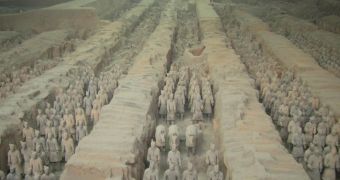In 1974, Chinese farmers digging for a well accidentally made the biggest archaeological discovery ever in China: the tomb of the emperor Qinshihuang, of the Qin dynasty, which in 221 BC, unified China for the first time after extremely bloody wars. The western name of the country, China (Chinese people call themselves Han) comes from Qin dynasty.
The tomb was defended for over 2,000 years by 8,000 life-size terracotta warriors and horses, buried in the pits near the mausoleum, but it has kept for 30 years another secret. After five years of investigation, archaeologists have confirmed that a 30m (100 ft) high building is buried in the vast mausoleum of Emperor Qinshihuang near the ancient capital, Xian, in the northwestern province of Shaanxi.
The mausoleum is 51 m (170 ft) high and pyramid-shaped, having four surrounding stair-like walls.
"The discovery came as a complete surprise because there is no description of the 30m high building in surviving historical records. The building might have been constructed for the soul of the emperor to depart," said Duan Qingbo, a researcher with Shaanxi Institute of Archaeology.
The researchers have been employing remote sensing technology since 2002 to investigate the internal structure of the unexcavated mausoleum.
"Remote sensing technology is used to investigate the structure as the authorities have yet to allow the excavation of the emperor's tomb. They concluded that the building, buried above the main tomb, had four surrounding stair-like walls with nine steps each," the Xinhua agency said.
The main reason for keeping the tomb closed is the need to wait until archaeological techniques become sophisticated enough to potentially probe some of the most important finds of all time.
Despite his cruelty during leadership, Emperor Qin is regarded as the hero that achieved for the first time the unity of China.

 14 DAY TRIAL //
14 DAY TRIAL //